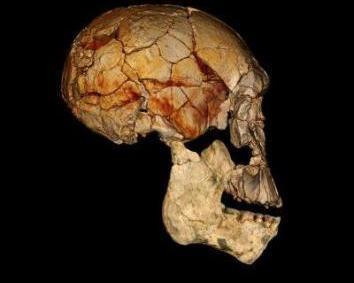
Fossils show two additional species of our genus Homo lived alongside our direct ancestral species in Africa almost 2 million years ago, scientists say.
The discovery near Lake Turkana in Kenya confirms that a fossil skull found 40 years ago was a different species of early Homo living alongside Homo erectus during the Pleistocene epoch.
That skull, dubbed KNM-ER 1470, missing the teeth and lower jaw but distinguished by a large brain size and long flat face, started a longstanding debate about just how many different relatives of early man lived during that period.
Two new fossils may have settled the debate, the National Geographic Society, which funded the research, said in a release Wednesday.
“For the past 40 years we have looked long and hard in the vast expanse of sediments around Lake Turkana for fossils that confirm the unique features of 1470‘s face and show us what its teeth and lower jaw would have looked like,” Meave Leakey, a National Geographic explorer-in-residence, said. “At last we have some answers.”
The new fossils include a face, a remarkably complete lower jaw, and part of a second lower jaw.
“Combined, the three new fossils give a much clearer picture of what 1470 looked like,” researcher Fred Spoor said. “As a result, it is now clear that two species of early Homo lived alongside Homo erectus.”
“The new fossils will greatly help in unraveling how our branch of human evolution first emerged and flourished almost 2 million years ago.” (UPI)
<관련 한글 기사>
학계 발칵! '또 다른 인류' 발견되었다!
현대인류 (호모 사피엔스 사피엔스)의 직계 조상인 ‘호모 에렉투스' 외에도 2백만년전 아프리카에 두 종류의 다른 고대 인류(사람속)가 더 존재했다는 사실이 화석을 연구하는 과학자들에 의해 밝혀졌다.
케냐 투르카나 호수 인근에서 40년 전 발견된 두개골 화석은 홍적세(혹은 플라이스토세)에 지구상에 존재했던 현대인류의 직계 조상 호모 에렉투스 이외에도 동기간에 존재했던 다른 종류의 고대 인류의 것으로 밝혀졌다.
40년 전에 발견되어 KNM-ER 1470이라고 명명되었던 이 두개골은 치아와 아래턱뼈가 없지만 큰 두뇌용적과 길고 평평한 안면부를 지니고 있어 홍적세에 얼마나 많은 기타 고대 인류가 존재 했는가에 대한 긴 논쟁을 야기시켜왔다.
그러나 내셔널지오그래픽소사이어티(National Geographic Society)가 수요일 발표한 새 화석자료를 통해 이와 같은 길고 긴 논쟁이 종식될 것으로 보인다.
이 새 화석들은 안면부와 더불어 완벽한 보존상태를 보이고 있는 아래턱뼈를 포함하고 있다.
화석 연구구원 프레드 스푸어는 “이번에 발견된 새 화석을 통해 종전의 1470 화석의 본래 모습이 어떠했을 지를 확실히 추정할 수 있다. 결과적으로 1470 화석이 호모 에렉투스와 동시대에 존재했던 또 따른 고대 인류의 두개골임이 확실해졌다.”고 밝혔다.
그는 이어, “이번에 발견된 새 화석을 통해 2백 만년 전 인류 진화의 첫 번째 갈래가 어떻게 발생했으며 진행되어 왔는지를 파악하는데 큰 도움을 얻게 되었다.”고 덧붙였다.
코리아헤럴드(khnews@heraldcorp.com)
<이 시각 인기 기사>
"남자들, 이럴때 통통녀에게 끌린다"
‘분노한’ 일본인, 한국영사관에 벽돌 던져
'외계의 호수' 붉은 물이 흐르는 이유
태양 300배 괴물 별... 대체 어떻게?!
-
Articles by Korea Herald






![[Weekender] How DDP emerged as an icon of Seoul](http://res.heraldm.com/phpwas/restmb_idxmake.php?idx=644&simg=/content/image/2024/04/25/20240425050915_0.jpg&u=)


![[Music in drama] An ode to childhood trauma](http://res.heraldm.com/phpwas/restmb_idxmake.php?idx=644&simg=/content/image/2024/04/25/20240425050929_0.jpg&u=)









![[Herald Interview] Mistakes turn into blessings in street performance, director says](http://res.heraldm.com/phpwas/restmb_idxmake.php?idx=652&simg=/content/image/2024/04/28/20240428050150_0.jpg&u=20240428174656)
